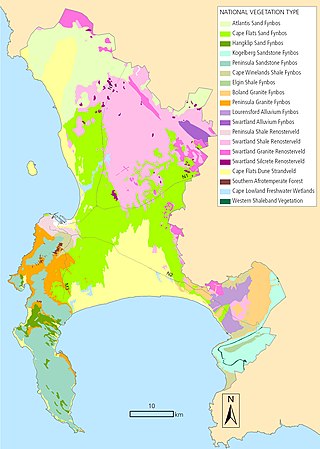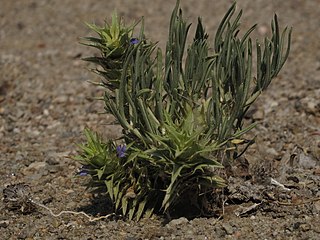
The honey badger, also known as the ratel, is a mammal widely distributed in Africa, Southwest Asia, and the Indian subcontinent. Because of its wide range and occurrence in a variety of habitats, it is listed as Least Concern on the IUCN Red List.

The Cape hare, also called the brown hare and the desert hare, is a hare native to Africa and Arabia extending into India.

The Cape honey bee or Cape bee is a southern South African subspecies of the western honey bee. They play a major role in South African agriculture and the economy of the Western Cape by pollinating crops and producing honey in the Western Cape region of South Africa. The species is endemic to the Western Cape region of South Africa on the coastal side of the Cape Fold mountain range.

The Cape cormorant or Cape shag is a bird endemic to the southwestern coasts of Africa.

The Cape weaver is a species of bird in the weaver family, Ploceidae, found in southern Africa.

The African clawless otter, also known as the Cape clawless otter or groot otter, is the second-largest freshwater otter species. It inhabits permanent water bodies in savannah and lowland forest areas through most of sub-Saharan Africa. It is characterised by partly webbed and clawless feet, from which their name is derived. The word 'aonyx' means clawless, derived from the prefix a- ("without") and onyx ("claw/hoof").

The yellow bishop, also known as Cape bishop, Cape widow or yellow-rumped widow, is a resident breeding bird species in Angola, Botswana, Burundi, Cameroon, Congo, Equatorial Guinea, Eswatini, Ethiopia, Kenya, Lesotho, Malawi, Mozambique, Nigeria, Rwanda, South Africa, South Sudan, Tanzania, Uganda, Zambia and Zimbabwe.

Blepharis is a genus of plant in family Acanthaceae. It contains around 128 species found in seasonally dry to arid habitats from Africa through Arabia to Southeast Asia. In section Acanthodium, there are 13–15 species that use the C4 carbon fixation pathway. Phylogenetic analysis suggests that this pathway evolved up to three times independently in the genus over the last five million years.

Anna Amelia Mauve was a South African botanist who worked at the Botanical Research Institute in Pretoria. She catalogued more than 4,000 plant specimens from the Kalahari and Soutpansberg regions. She made major contributions to the journals Flowering Plants of Africa and Bothalia.
Alenia namaqua, the Namaqua dancer or Namaqua sandman, is a species of butterfly of the family Hesperiidae. It is only known from Namaqualand in the Northern Cape of South Africa, from Calvinia north through Kamiensberg into Namibia.
Alenia sandaster, the Karoo dancer or Karoo sandman, is a species of butterfly in the family Hesperiidae. It is only known from the arid Nama Karoo of the eastern part of the West Cape, the central North Cape and the western East Cape in South Africa.
The Milnerton Racecourse Nature Reserve is a lowland conservation area located in the City of Cape Town, South Africa.
The Diep River Fynbos Corridor is a nature reserve located in the Blaauwberg region of Cape Town, South Africa. It forms part of the larger Table Bay Nature Reserve, which was established in June 2012.

The Biodiversity of Cape Town is the variety and variability of life within the geographical extent of the City of Cape Town metropolitan municipality, excluding the Prince Edward Islands. The terrestrial vegetation is particularly diverse and much of it is endemic to the city and its vicinity. Terrestrial and freshwater animal life is heavily impacted by urban development and habitat degradation. Marine life of the waters immediately adjacent to the city along the Cape Peninsula and in False Bay is also diverse, and while also impacted by human activity, the habitats are relatively intact.

Southern Afrotemperate Forest is a kind of tall, shady, multilayered indigenous South African forest. This is the main forest-type in the south-western part of South Africa, naturally extending from the Cape Peninsula in the west, as far as Port Elizabeth in the east. In this range, it usually occurs in small forest pockets, surrounded by fynbos vegetation.

Blepharis grossa is a species of plant in the family Acanthaceae native to Angola, Namibia, and the Cape Provinces.

The Tstsikamma Marine Protected Area is a marine protected area on the south coast of South Africa, in both the Western Cape and Eastern Cape. It is on the coast of the Tsitsikamma National Park, and is one of the oldest MPAs in the country. The MPA provides protection for marine habitat and wildlife, including birds and threatened and endangered fish species.













